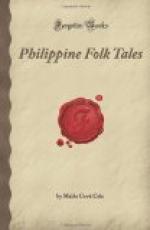[61] See note 1, p. 45.
[62] The labeug is the omen bird and is believed to be the direct messenger of Kadaklan, the great spirit, to the people.
[63] See note 1, p. 34.
[64] See note 1, p. 8.
[65] See Preface, p. vii.
[66] Before the bundles of ripened rice can be put into the granary a ceremony is made for the spirits. The blood of a pig is mixed with cooked rice and put in the granary as an offering for the spirit who multiplies the grain, otherwise the crop would run out in a short time.
[67] See note 1, p. 9.
[68] The spirit who stands next in importance to Kadaklan, the great spirit. It was he who taught the people all good things, and finally he married a woman from Manabo in order to bind himself more closely to them. See “How the Tinguian Learned to Plant.”
[69] This story is considered by the Tinguian to be of rather recent origin. They believe that Sayen lived not so very long ago, yet the stories woven around him are very similar to the ancient ones.
[70] See “The Alan and the Hunters.”
[71] The Tinguian now use flint and steel for making a flame, but it is not at all uncommon for them to go to a neighbor’s house to borrow a burning ember to start their own fire.
[72] The neighboring Ilocano, a Christianized tribe, know the Komow as a fabulous bird which is invisible, yet steals people and their possessions.
[73] See note 1, p. 59.
[74] See note 2, p. 20.
[75] This tale is of special importance to the Tinguian since it explains how they learned two of the most important things of their present life—to plant and to cure the sick. It also shows how death came into the world.
[76] See note 1, p. 59.
[77] It is a common sight in a Tinguian village early in the morning during the dry season to see a number of men armed with spears and head-axes leaving for the mountains. They usually take with them, to assist in the chase, a string of half-starved dogs. Often a net is stretched across the runway of game, and then, while some of the hunters conceal themselves near by, others seek to drive the game into the net, where it is speared to death.
[78] Ancient Chinese jars are found throughout the interior of the Philippines and are very closely associated with the folk-lore of the Tinguian. Some of the jars date back to the 10th century, while many are from the 12th and 14th centuries, and evidently entered the Islands through pre-Spanish trade. They are held in great value and are generally used in part payment for a bride and for the settlement of feuds. For more details see Cole, Chinese Pottery in the Philippines, Pub. Field Museum of Nat. Hist, Vol. XII, No. 1.
[79] This cave is situated in the mountains midway between Patok and Santa Rosa. In this vicinity are numerous limestone caves, each of which has its traditions.




